Garage - the room is usually unheated. Nevertheless, a certain temperature and humidity regime must be maintained here. This is provided by insulation of the ceiling and walls in the garage from the inside.
- Why insulate the ceiling in the garage
- Types of heaters
- Polyurethane foam liquid or polyurethane foam
- Fiberglass materials
- Basalt or stone wool
- Thermal insulation outside and inside
- How to insulate the ceiling in the garage with your own hands
- Insulation from the attic side
- Garage roof insulation technology from the outside
Why insulate the ceiling in the garage
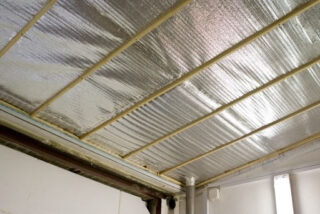
According to SNiP norms, the temperature of the box for the car must be kept within the range from 0 to +25 C, and the humidity - in the range from 60 to 80%. In a brick or wooden building, it is not difficult to maintain such a temperature in winter, especially in middle latitudes. Humidity is worse.
Building stone is a rather porous material. Moisture penetrates through the stone into the garage. And since the air temperature is higher inside, condensation falls on the walls, ceiling and body of the car. This is the main danger, since water provokes the formation of rust on any steel parts.
Insulation of the ceiling in the garage solves a number of problems:
- The room loses most of its heat through the ceiling. Thermal insulation ensures temperature stabilization in the box.
- The heat insulator creates a kind of thermal barrier. Warm air collides not with a cooled concrete surface, but with a warm one, which means that condensation does not form.
- Through small, almost invisible cracks in the roof, moisture penetrates inside. If the ceiling is thermally insulated, this is not possible.
- Warming involves surface finishing. The garage becomes more comfortable.
It makes no sense to insulate a metal box. To compensate for the thermal conductivity of the metal, the thermal insulation layer must reach significant values.
Types of heaters

Insulation requirements for garage boxes are low, so the choice of materials is almost unlimited. Any types are used:
- Slabs - polystyrene, penoplex. They have very high heat saving rates, are lightweight, and are not afraid of mold. Installation of slab insulation is extremely simple. The downside is low fire safety.
- Roll - mineral wool, basalt, isolon. It is a loose fibrous material, lightweight, non-flammable, not afraid of fire. It is attracted by its low price and availability. Minus: the material is afraid of moisture, it must be carefully waterproofed.
- Lubricants - modern materials, including a foaming agent. On contact with air, such a heat insulator forms foam and then solidifies. Very easy to use, but expensive.
Even heat-insulating plasters can be used to insulate the garage. They include vermiculite, sawdust, expanded clay. And although the layer of plaster on the ceiling is small, it is enough to maintain a stable temperature inside the room.
For garages, it is recommended to choose non-combustible materials.
Polyurethane foam liquid or polyurethane foam
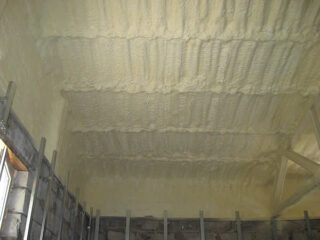
Polyurethane foam is a representative of liquid insulation. It is applied under pressure. On contact with air, forms a light, loose foam. The latter fills in the slightest gaps and differences in height, and then solidifies.
The advantages of this option:
- thermal insulation properties are higher than that of board materials;
- cold bridges are excluded: foam fills the cracks and envelops the protrusions;
- the foam layer is not afraid of water, sun, completely non-combustible;
- PUF allows steam to pass through to some extent, unlike board polymers, so that steam from warm air does not accumulate in the garage;
- the material is not subject to any type of corrosion, is chemically inert;
- insulation is performed in a matter of hours.
The disadvantage is the high cost and method of application: special equipment is required to supply the material.
In addition to polyurethane foam, it is recommended to take penoizol for garage insulation. An additional plus of this material is high sound insulation.
Fiberglass materials
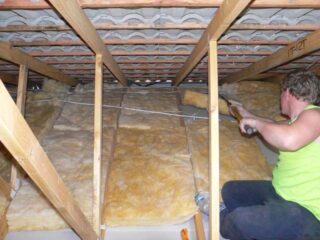
You can insulate the ceiling in the garage with fiberglass. The material is obtained by recycling glass waste. It is melted down, drawn into thin threads and pressed into plates. Fiberglass has many benefits:
- the material does not burn and does not support combustion, withstands heating to very high temperatures;
- due to its loose light structure, it provides excellent thermal insulation;
- not subject to any kind of corrosion, not afraid of ultraviolet radiation;
- mice do not start in glass wool;
- the material is produced in the form of mats and rolls, it is easy to work with it;
- fiberglass weighs little, so it is quite suitable for warming the ceiling surface.
The disadvantages are significant:
- Glass fibers are fragile, and the structure can be easily destroyed if excessive pressure is applied to the plates, so the material must be handled carefully.
- When the fibers are crumbled, the finest glass dust is formed. It irritates the mucous membranes and is very dangerous. Work with fiberglass in a respirator and protective gloves.
Fiberglass lasts much longer than other roll materials, as it is absolutely not afraid of water. If the insulation gets wet, after drying, its thermal insulation properties are fully preserved.
Basalt or stone wool
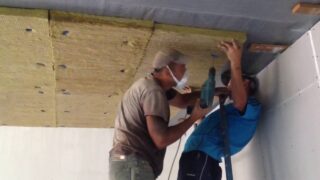
The material is obtained from rock basalt rocks. In terms of thermal insulation characteristics and strength, it is similar to fiberglass. But unlike the last mineral wool, it is more flexible and elastic, so the plates can be attached to curved surfaces.
The downside of stone wool is the fear of water. When wet, the material loses its properties. During installation, the insulation must be carefully waterproofed.
Thermal insulation outside and inside
External insulation is recommended for thin-sheet structures: metal or lightweight concrete buildings without a foundation. It is recommended to use spray or coating materials, as they are much easier to work with. Installation of slab or roll insulation requires an unreasonable amount of time and effort.
Interior finishing is carried out in capital buildings. You can insulate the garage from the inside at any time. All materials are allowed to be used - from polyurethane foam to stone wool.
How to insulate the ceiling in the garage with your own hands
In any case, it is recommended to insulate the ceiling from the inside. There is not a large enough space under the roof where you can place a frame with insulation and waterproofing. But the cavities between the rafters can be used for laying.
Insulation from the attic side
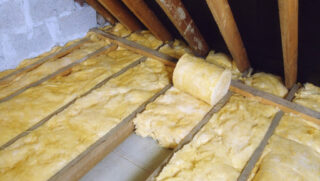
If the cold attic is high enough to move under the roof, insulate the ceiling from the outside.
- Waterproofing is laid on the floor of the attic - a film, roofing material. The joints are glued with tape.
- If the ceiling beams are placed on the inside, a frame is erected on the floor. If from the side of the attic, they are used as cells for insulation.
- Mineral wool, fiberglass, slabs are placed in the lathing cavity.
- Cover the insulation with a vapor barrier.
- Close up the floor with edged boards. Since the attic in the garage is uninhabited, waste material is taken for flooring.
You can use bulk insulation - expanded clay, vermiculite. It's cheaper.
Garage roof insulation technology from the outside

This method is used when insulating concrete buildings with a flat roof.Arrangement of such thermal insulation is more difficult and more expensive. Step-by-step instruction:
- A pillow of expanded clay, gravel or crushed stone 5 cm thick is poured onto the cleaned concrete surface.
- Lay a waterproofer - better roofing material in 2 layers. The joints are sealed with bituminous mastic.
- Insulation is placed on top. They choose materials that are not afraid of water, since here waterproofing will never give 100% protection.
- The structure is poured with concrete. It is recommended to reinforce the concrete layer.
- When the screed is dry, the finish is laid. For simple construction, it is enough to fill the surface with hot bitumen.
The insulation on the roof is subject to additional mechanical stress. You need to choose not only a hydrophobic material, but also durable: expanded clay, perlite, expanded polystyrene.








